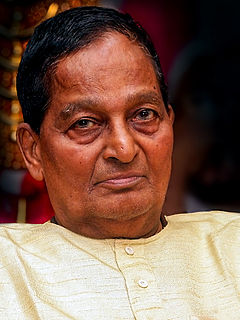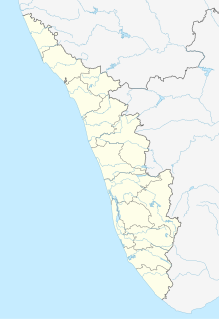Related Research Articles

Kalaripayattu, also known simply as Kalari, is an Indian martial art that originated in modern-day Kerala, a state on the southwestern coast of India. Kalaripayattu is known for its long-standing history within Indian martial arts. It is believed to be the oldest surviving martial art in India, with a history spanning over 3,000 years.
N. Kumaran Asan was an Indian social reformer, philosopher and poet of Malayalam literature. He is known to have initiated a revolution in Malayalam poetry in the first quarter of the 20th century, transforming it from the metaphysical to the lyrical and his poetry is characterised by its moral and spiritual content, poetic concentration and dramatic contextualisation. He is one of the modern triumvirate poets of Kerala and a disciple of Sree Narayana Guru.
A kalari is a gymnasium or training space primarily associated with the martial art of Kalaripayattu. The word kalari comes from Malayalam and Tamil. Also, the past village schools of Kerala, run by the traditional astrologers families, were known by the name kalari or Ezhuthu Kalari. It is also associated with the martial art of Varma adi.
The State Council of Educational Research and Training (SCERT), Kerala is a board of school education in India, conducted by the government of the state of Kerala, India. The board prepares the syllabus for schools affiliated with it. Their main academic focus is on medical care, engineering and telemarketing.

Vadakke Manalath Govindan Nair popularly known as Kalamandalam Gopi, is an Indian dancer who is an exponent of the classical dance-drama style known as Kathakali.
Panicker is a title or last name. Panicker is an ethnic group belonging to the Hindu religion, who live in the South Malabar and central parts of the Indian state of Kerala. They were well known as the masters of Kalari tradition, having their Nalpatheeradi Kalari. They are the people who propagated and practised Kalaripayattu, the martial art form of Kerala.

Mooloor S. Padmanābha Panicker (1869-1931) was a poet and a prominent social reform activist from the Travancore region of present-day Kerala.
Unniyarcha is a legendary warrior and heroine mentioned in the Vadakkan Pattukal, a set of ballads from Kerala, a state in southwestern India. She was a member of a Chekavar(Thiyyar) family of Puthooram Veed in Kadathanad.Her father's name was Kannappa Chekavar. She is believed to have lived in the northern part of Kerala during the 16th century. She is a popular character in Kerala's folklore, and is remembered for her valour and skills in Kerala's native martial art, Kalaripayattu. According to legend, Unniyarcha was most known for her deadly skill with the whip-like Urumi, a unique type of sword that is native to Kerala and Sri Lanka. Like most traditional Kalaripayattu practitioners, she began training at the kalari at the age of seven.
Kaniyar is a caste from the Indian state of Kerala. There are regional variations in the name used to define them. They are listed under the Other Backward Communities (OBC) by the Kerala Government.

Thumpamon is a village in Pandalam(5 km Approx), a part of Adoor thaluk in Kerala, India. One of the greatest attractions of this village is the Achenkovil River, which is known for its natural sceneries along the riverbank. The village relies on Non-resident Indian (NRIs) and crops like rubber, coconut, paddy and pepper. But, the most common crop in the village is rubber. Because of Non-Resident Indians, this is one of the wealthiest villages in Kerala. Thumpamon is divided into two regions, Thumpamon North and Thumpamon South, by the Achenkovil River.

Peringottukara is a village in the western coastal side of India, located on the western side of Thrissur district, Kerala. The village is much famous for Vishnumaya Temples. Peringottukara village includes kizhakkumuri, vadakkumuri, and peringottukara center. Peringottukara village has main two junctions, the four-way junction, and three-way junction. The four-way junction has a petrol pump, three-star hotel, hypermarket, nationalized bank, Co-operative banks, and grocery stores. Peringottukara 3 way junction also has the same facilities. There are Chathan Seva temples at Peringottukara, such as Kanadi Kavu, Avanangattu Kalari, and Devasthanam. Among these Kanadi Kavu is the biggest and oldest Temple. The biggest built, Shiva Parvathy Vishnumaya Terracotta Statue in Kerala is situated in front of the Peringottukara devasthanam, Its height is 52 ft.

Padayani, also known Padeni, is a traditional folk dance and a ritual art from the central portion of the Indian state of Kerala. A ceremonial dance involving masks, it is an ancient ritual performed in Bhagavati temples. The dance is performed in honor of Bhadrakaali. Meaning, a 'row of warriors', Padayani is an art form that blends music, dance, theatre, satire, facial masks, and paintings. It is part of worship of Bhadrakali and is staged in temples dedicated to the goddess from mid-December to mid-May. Padayani is unique to central Travancore, comprising the Pathanamthitta and kottayam districts of Kerala. Padayani is regarded as a remnant of the Dravidian forms of worship that existed before the advent of Brahmanism.
Kalari Panicker / Kalari Kurup is an ethnic group belonging to the Hindu religion, who live in the South Malabar and central parts of the Indian state of Kerala. They were well-known as the masters of Kalari tradition, having their Nalpatheeradi Kalari. They are the people who propagated and practiced Kalaripayattu, the martial art form of Kerala. The National Commission of Backward Classes lists Kalari Kurup or Kalari Panicker under the list of OBCs. The titles Panicker and Kurup are prevalent in several other communities in Kerala, eg. Illathu or Kiriyathil Panicker who belong to the Nair community, and should not be confused with Kalari Panicker or Kalari Kurup.

Āsān is a Malayalam and Tamil word that means teacher or guide.
The Thalassery carnival, the Beach fest in Muzhappilangad beach and Dharmadam beach are notable attractions. The area's four rivers around Thalassery town and four beaches with more in Kannur also attract visitors.

The British had considerable impact on the culture of Thalassery. As an ancient trade center, the trading and business relations that existed with the Europeans and the Arabs brought people and ideas from many other lands. The Christian missionaries and the educational reforms they brought played an important role in transforming society. The migration to Travancore during Hyder Ali and Tipu Sultan's invasion was another factor, resulting in less social distance between upper and lower castes from the 18th to mid-20th centuries. This effect did not reach the Travancore Cochin area, which was not under the Madras Presidency, where inequality was greater.
Pallikoodam or Pallikkoodam is a word in Malayalam and Tamil that denotes a school. These were mostly village schools run by individual teachers and were distinct from Kalaris that taught martial arts.
Meenakshi Amma is a practitioner and teacher of Kalaripayattu, the traditional martial arts form of Kerala, India. In 2017, she received Padma Shri, India's fourth highest civilian award. She is from Vadakara, a town in northern Kerala. Every year, 150-160 students learn the martial arts in her school Kadathanadan Kalari Sangam, where she is teaching for more than 56 years. Meenakshi Amma was introduced to Kalaripayattu at the age of seven under V P Raghavan Master, whom she married at the age of 17. After her husband's death in 2007, Meenakshi Amma took over the reins of the Kadathanattu Kalari Sangham established by her husband. She is well-versed in using all the weapons ranging from the stick to the urumi, which even the experts find difficult to master.

Avanangattilkalari Sree Vishnumaya Temple is a Hindu temple at peringottukara, Thrissur District, Kerala state, India. It is dedicated to the god Vishnumaya in Kerala. The god is known also by the names Chathan.
Mathoor Govindan Kutty was an Indian Kathakali artist from the state of Kerala. In a career spanning over six decades, he specialized in Kathakali Stri Vesham, the portrayal of female characters on stage. He was the recipient of the 2011 Kerala State Award for the best Kathakali artist and the 2005 Sangeet Natak Akademi Award for contributions to the Kathakali art form.
References
- ↑ Raja, Dileep.G (2005). "Of an old school of teachers". The Hindu . Thiruvananthapuram. Archived from the original on 2014-10-15.
- ↑ Kerala District Gazetteers: Quilon ,Kerala (India), A. Sreedhara Menon , page 423
- ↑ People of India, Volume 27, Part 3 ,Anthropological Survey of India Kumar Suresh Singh, page 1613